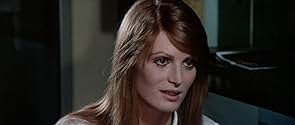Agrega una trama en tu idiomaA number of women are brutally murdered. It quickly becomes apparent that all the victims are connected to a woman who had been having illicit affairs with them.A number of women are brutally murdered. It quickly becomes apparent that all the victims are connected to a woman who had been having illicit affairs with them.A number of women are brutally murdered. It quickly becomes apparent that all the victims are connected to a woman who had been having illicit affairs with them.
- Dirección
- Guionistas
- Elenco
- Anna
- (as Pier Anna Quaia)
- Mario the coiffeur
- (as Giovanni Brusatori)
- Dirección
- Guionistas
- Todo el elenco y el equipo
- Producción, taquilla y más en IMDbPro
Opiniones destacadas
Director Tano Cimarosa seems keen to keep the focus on sleaze and savagery throughout, and if we're not witnessing a woman being slashed open with a razor blade, we're watching two of them getting it on. Normally, a film like this would get a high rating from me; but because the cinematography is so painful, none of it is pleasing to the eye and that ensures that it's all rather uninspiring. The cast features two recognisable names, those belonging to John Richardson, the star of a number of Italian films including Bava's Black Sunday and Lenzi's Eyeball, and Dagmar Lassander; who also appears on a number of cult cast lists. Neither really has room to impress here. Despite putting more focus on sleaze, the plot is actually quite complicated; and is made more so by the fact that all the characters are wafer thin and it can be difficult to work out their motives because of that. The ending doesn't come as much of a surprise, although I wasn't really expecting it to. Overall, Reflections in Black really isn't a good film; but I hesitate to completely condemn it as it's a great exercise in crappy film-making, and it does at least do some of the things that you want a Giallo to do.
Yep, the killer has black gloves and an open razor, the victims are young and often naked ladies, and there's loads and loads of nudity to keep you awake between the interminable police investigation scenes. The main focus seems to be mainly on John Richardson the policeman and his sidekick, who suspiciously is played by director/actor Gaetano. There's also a keen rookie cop and his girlfriend that clog up the investigation side of things too, and bulk out the plot.
As usual a photograph is a main plot point, there's a few effective stalking scenes, but even the rampant nudity couldn't really carry this one all the way through. They didn't give Giacomo Rossi-Stuart enough screen time either.
This is certainly one of the least impressive examples of the Italian giallo that I have seen. It was directed by Tano Cimorosa, who also plays the diminutive detective with the 'tache. Cimorosa will be familiar to a lot of you from his memorable appearance in Renato Polselli's brutally sleazy giallo Delirium (1972). Well this movie sure has its fair share of sleaze as well but it's a much less entertaining affair. On the one hand it certainly contains many of the giallo conventions such as a convoluted mystery, violent murders and a healthy amount of nudity; on the other hand it completely lacks any sense of style. As a result it merely comes off as rough edged and at best semi-interesting. It stars giallo regulars such as Dagmar Lassander and Giacomo Rossi-Stuart but they aren't really given a lot to do.
It should be pointed out that the copy I saw was pan and scan and 72 minutes, with poor sound. Perhaps if I saw it in a better version my opinion would improve, as I do believe that there is a 90 minute cut out there. But my main feeling is that the basic ingredients of this one are not terrific no matter the version.
Overall it's not actually bad, it's just not good either and has no atmosphere whatsoever which is unfortunate in a giallo film. But it's better than I originally thought.
¿Sabías que…?
- TriviaWhen the cultured but assumedly heterosexual dress designer happens to employ the French phrase "mise en scene" to "set the scene" for his testimony, Sgt. Panto, who just assumes all designers and hairdressers are automatically gay [he's previously insinuated that the couturier wears his own wares, and later professes the belief that the guy's a "fag"], on a hunch it must be something subversive and immoral, mimics back "mise en shame", so as to indicate, wrongly, that he knows it's pervy code for a proposition to commit some sort of disgusting same-sex act.
- ErroresWhen the cultured but assumedly heterosexual dress designer happens to employ the French phrase "mise en scene" to "set the scene" for his testimony, Sgt. Panto, who just assumes all designers and hairdressers are automatically gay [he's previously insinuated that the couturier wears his own wares, and later professes the belief that the guy's a "fag"], on a hunch it must be something subversive and immoral, mimics back "mise en shame", so as to indicate, wrongly, that he knows it's pervy code for a proposition to commit some sort of disgusting same-sex act.
- Citas
Dressmaker: Our work requires a certain "mise en scene." ... Do you understand Sergeant?
Sgt. Pantò: Well,,, I try ... So I wanted to ask you if you ever dressed as a woman?
Dressmaker: Me, dress as a woman? Why would I?
[Panto stutters, trying to avoid an indelicate or explicit response]
Dressmaker: Mise en scene?
Sgt. Pantò: [cutting him off, relieved he didn't have to say it first] "Mise en shame!" Exactly!

























